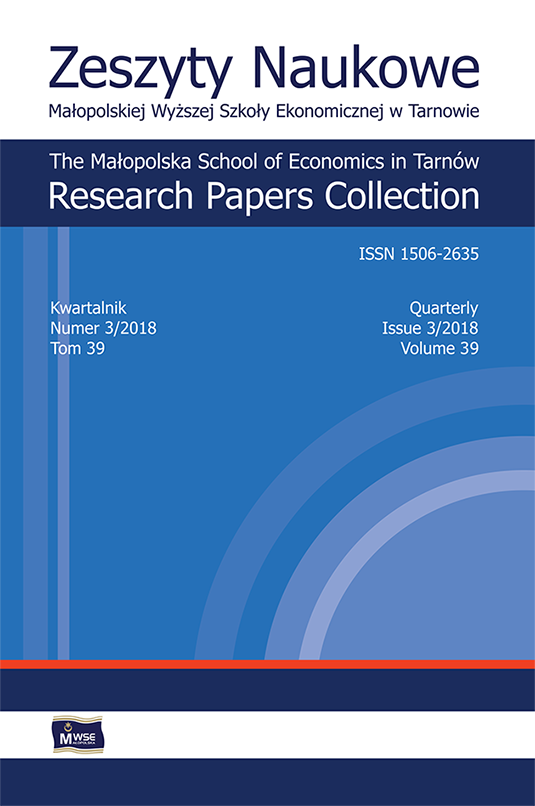Abstract
The aim of this article is assess the effectiveness of expenditure of the Visegrád Group countries on research and development in comparison to the average for EU countries. It will be formulated with indicators showing the amount of exports of high-tech products, the number of patent applications and the number of citations of scientific publications per volume of expenditure. The Eurostat and Scimago Journal & Country Rank databases were used to structure the indicators, and the time scope of the analysis covers the years 2000–2016 and depends on the availability of data. Research and development are important for developing countries due to the technological gap that separates them from highly developed countries and the threat of the middle-income trap. The countries of the Visegrád Group joining the European Union have adopted common rules for shaping economic policy. An important part of it is the innovation policy, which aim is developing the research sphere. Data showing R&D spending as a % of GDP show that V4 countries achieve a lower than the EU average and a 3% level of expenditure assumed in the Horizon 2020 programme. Based on the analysis of effectiveness indicators, it can be stated that in the case of high-tech exports and the number of citations of scientific publications, the Visegrád Group countries achieve higher than average EU effectiveness, while in the case of the number of patent applications they are characterized by lower effectiveness.
References
Dąbkiewicz, M. (2017). Wpływ sektora B+R na konkurencyjność gospodarki polskiej. Studia Ekonomiczne. Zeszyty Naukowe Uniwersytetu Ekonomicznego w Katowicach, 311, 208–219.
View in Google Scholar
Firszt, D. (2010). Niwelacja luki technologicznej względem krajów rozwiniętych jako jeden z wymiarów modernizacji polskiej gospodarki. Nierówności Społeczne a Wzrost Gospodarczy, 16, 225–233.
View in Google Scholar
Gawron-Tabor, K. (2013). Współpraca państw Grupy Wyszehradzkiej w procesie integracji europejskiej w latach 1989–2009. Toruń: DUET. ISBN 9788362558681.
View in Google Scholar
Komisja Europejska. (2014). Badania naukowe i innowacje [online, dostęp: 2018-07-12]. Luksemburg: Urząd Publikacji Unii Europejskiej. ISBN 9789279423970. Dostępny w Internecie: https://europa.eu/european-union/sites/europaeu/files/research_pl.pdf. DOI 10.2775/75059.
View in Google Scholar
Niklewicz-Pijaczyńska, M., Wachowska, M. (2012). Wiedza, kapitał ludzki, innowacje. Wrocław: Prawna i Ekonomiczna Biblioteka Cyfrowa 2012. ISBN 9788361370802.
View in Google Scholar
Piekutowska, A., Wrońska, I. (2015). Ten years of the Visegard Group member states in the European Union. Warszawa–Białystok: ASPRA. ISBN 9788375455830.
View in Google Scholar
Ratajczak-Mrozek, M. (2011). Specyfika przedsiębiorstw zaawansowanych technologii (high-tech). Przegląd Organizacji, 2, 26–29.
View in Google Scholar
Sawulski, J. (2018). Efektywność wydatków na badania i rozwój w Polsce na tle innych państw Unii Europejskiej. Warszawa: Difin. ISBN 9788380855618.
View in Google Scholar
Skrzypek, E. (2011). Gospodarka oparta na wiedzy i jej wyznaczniki. Nierówności Społeczne a Wzrost Gospodarczy, 23, 270–285.
View in Google Scholar
Węgrzyn, G., Balana, N. (2013). Gospodarka oparta na wiedzy i usługach – analiza porównawcza. Ekonomia, 1(22), s. 61–72.
View in Google Scholar
Wojtyna, A. (2016). Kontrowersje teoretyczne wokół koncepcji pułapki średniego poziomu rozwoju. W: A. Wojtyna (red.). Średni poziom rozwoju gospodarczego: pułapka czy szansa? (s. 9–24). Warszawa: Wydawnictwo Naukowe PWN. ISBN 9788301187156.
View in Google Scholar
Zakrzewska-Bielawska, A. (2011). Relacje między strategią a strukturą organizacyjną w przedsiębiorstwach sektora wysokich technologii. Łódź: Wydawnictwo Politechniki Łódzkiej.
View in Google Scholar
© Copyright by Małopolska School of Economics in Tarnów. The articles are available under the Creative Commons Attribution NonCommercial-NoDerivatives 4.0 International License


